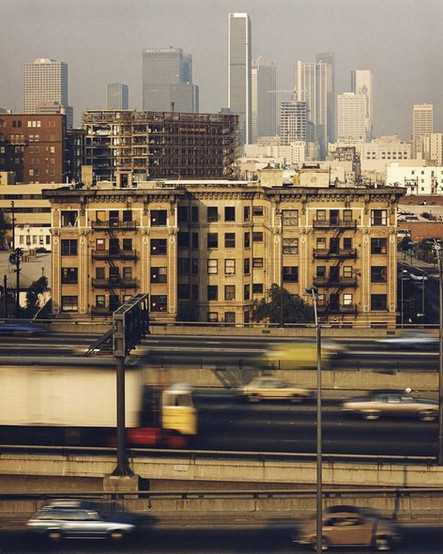The Transformative Decade: Los Angeles in the 1980s
- tristan8561
- May 24, 2023
- 3 min read

Welcome to the vibrant and transformative world of 1980s Los Angeles, a decade that witnessed the city's evolution on multiple fronts.From its shifting urban architecture to its socio-political dynamics, cultural expansions, and artistic renaissance, Los Angeles in the 1980s encapsulated a unique blend of creativity, contradictions, and cultural expressions.
The 1980s witnessed Los Angeles embracing architectural experimentation, resulting in a cityscape that was both visionary and eclectic. The Pacific Design Center, with its vibrant blue and green glass façade, emerged as a landmark of modern design. The Bonaventure Hotel's futuristic glass towers captured the imagination, while the Getty Center's striking architectural concept blended art and nature seamlessly. This era's architectural endeavors reshaped the skyline, reflecting the city's embrace of bold and innovative design.
Behind the glamorous façade, Los Angeles in the 1980s faced social and political challenges. The city grappled with racial tensions, gang violence, and the consequences of the war on drugs. The emergence of crack cocaine exacerbated existing inequalities, leading to a wave of violence that affected communities across Los Angeles. The highly publicized Rodney King incident in 1991 would later become a turning point, exposing deep-rooted divisions and sparking a quest for justice and social change.
Los Angeles in the 1980s pulsated with cultural diversity, as various subcultures found their voice and artistic expressions flourished. The music scene thrived, with genres like punk rock, new wave, and hip-hop reshaping the city's sonic landscape. The Go-Go's, X, and N.W.A. emerged as influential forces, capturing the spirit of rebellion and creativity. The city's iconic punk venues, including The Whisky a Go Go and The Roxy, became epicenters of artistic fervor, fostering a countercultural movement.
As the entertainment capital of the world, Los Angeles in the 1980s reigned supreme on the silver screen. Memorable films such as "Blade Runner," "E.T. the Extra-Terrestrial," and "L.A. Story" showcased the city's allure and became cultural touchstones. Los Angeles served as both backdrop and character, portraying the juxtaposition of glamor and grit that defined the city. These movies etched Los Angeles into the popular imagination and contributed to its iconic representation in pop culture.
The 1980s witnessed a flourishing artistic renaissance in Los Angeles, where artists shattered conventions and embraced new forms of expression. The "Light and Space" movement, led by visionaries like James Turrell and Robert Irwin, explored the interplay of light, space, and perception, challenging the boundaries of traditional art. Simultaneously, the Chicano art movement thrived, reflecting the experiences and struggles of the Mexican-American community and shedding light on their cultural heritage.
The 1980s were a golden era for sports and pop culture in Los Angeles. The Lakers, with their dazzling roster of Magic Johnson and Kareem Abdul-Jabbar, mesmerized basketball enthusiasts and dominated the NBA, securing multiple championships. The Dodgers, under the charismatic leadership of manager Tommy Lasorda, brought home the World Series title in 1981, igniting the city's passion for America's favorite pastime. These triumphant moments became part of the fabric of Los Angeles' cultural identity.
From architectural marvels to socio-political struggles, artistic expressions to cinematic triumphs, Los Angeles in the 1980s captured a city in flux, navigating the complexities of its identity while embracing a vibrant tapestry of cultures and artistic endeavors. This era's legacy continues to shape the essence of Los Angeles, ensuring its enduring allure for generations to come.
PHOTO GALLERY
Pic 1: Santa Fe Ave. at the 4th Street Bridge - 1987. Art by @phantomstreetartist. Photo by Ken Lubas.
Pic 2: DTLA as sent from the Olympic Auditorium - 1985. Photo by John Humble.
Pic 3: Beverly Hills Cop playing in Westwood - 1984. Photo by Craig Mathew.
Pic 4: Punks outside of LA City Hall ca. 1983. Photo by Mary Lou Fulton.
Pic 5: Investigating the damage inside the main library after the catastrophic fire - 1986. Photo from the UCLA Archives.
Pic 6: Wolfgang Puck outside of Spago - 1989. Photo by George Rose.
Pic 7: Looking west down Hollywood Boulevard from Bronson - 1986. Photo by Tony Barnard.
Pic 8: Knife-Ship by Claes Oldenburg at the MOCA - 1987. Photo from the Claremont Archives.
Pic 9: Angelyne towering above Vine back in 1986 - photo by William Reagh.
Pic 10: Entrance to the Olympic Village at the '84
Games. Photo from the Claremont Archives.


























Comments